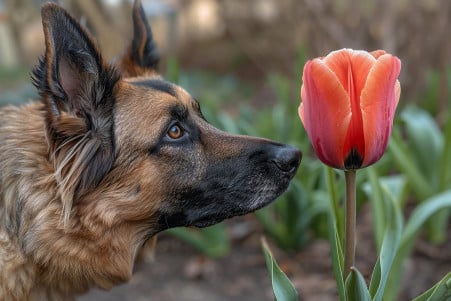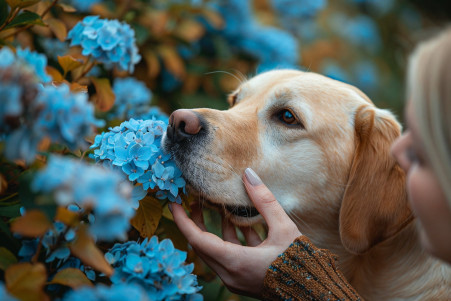Can Dogs Eat Lilacs? Potential Dangers
13 May 2024 • Updated 13 May 2024

While lilacs may be beautiful and smell great, that doesn’t mean that they’re safe for your dog to snack on. Lilacs are toxic to dogs when eaten, due to the presence of glycosides and other chemicals that can lead to symptoms like vomiting, lethargy, and abnormal heart rate or rhythm.
This article reviews the most up-to-date medical and veterinary studies to give you the information you need about what happens when dogs eat lilacs. This includes a review of chemical studies that detail the compounds in lilacs that cause toxicity, as well as case reports and observational studies of dogs that have eaten lilacs. This way, you can know what to look for and how to protect your dog if you have lilacs in your yard.
Are lilacs poisonous to dogs?
How to Tell the Difference Between Toxic and Non-Toxic Lilac Varieties
The common lilac (Syringa vulgaris) is the most popular type and is listed as non-toxic to dogs. On the other hand, the Persian lilac (Melia azedarach), also known as the chinaberry tree, is a different species and is toxic to dogs and other animals. It's important to be able to tell these two types of lilacs apart since the Persian lilac can cause serious issues if dogs eat it.
Common lilacs have large, sweet-smelling flower clusters and heart-shaped leaves, while Persian lilacs have smaller, less fragrant flowers and compound leaves. Other non-toxic lilac species include the Japanese tree lilac (Syringa reticulata) and the littleleaf lilac (Syringa pubescens subsp. patula), both of which are highly resistant to powdery mildew and other problems.
It's important to know the difference between these lilac species when planting and maintaining a garden. While the common lilac can provide beautiful flowers in your garden, the Persian lilac is toxic and should be avoided in areas where pets are present. By learning to recognize the differences between these species, you can enjoy lilacs without putting your dog at risk.
Signs and Side Effects of Lilac Toxicity in Dogs
If a dog has eaten a toxic species of lilac, like the Persian lilac, you may notice vomiting, diarrhea, lethargy, and abnormal heart rate or rhythm. The information provided also says that in more extreme cases, dogs may experience seizures, difficulty breathing, and neurological symptoms, all of which would require immediate medical attention.
The side effects of lilac toxicity can vary based on the amount of the plant that was ingested and the size of the dog. For example, smaller dogs and dogs that have eaten more of the plant are more likely to experience more severe side effects. Make sure to watch your dog closely for any signs of illness after you suspect they may have eaten lilac and take them to the vet right away if they show any symptoms.
First Aid and Emergency Treatment for Lilac Poisoning
If you think that your dog has eaten a poisonous lilac, the first thing you should do is try to get the remaining plant material out of their mouth and call your vet or an animal poison control center. You will need to know your dog's breed, the symptoms that they are experiencing, and the plant that you think they ingested.
Your vet may also tell you to induce vomiting or give your dog activated charcoal to help absorb the toxins. However, you should not induce vomiting if your dog is unconscious, having seizures, or if they have ingested a corrosive or caustic substance.
If your dog is having more serious symptoms, such as trouble breathing or seizures, you should take them to the vet immediately and not try to treat them at home. It's important to get medical help as soon as possible if you suspect that your dog has been poisoned by a lilac.
How to Avoid Lilac Poisoning: Dog-Safe Landscaping Tips
The most effective way to avoid lilac poisoning in dogs is to plant non-toxic lilac species like the Japanese tree lilac and other dog-safe plants in areas where your pet can reach them. Nature Hills nursery recommends that dog parents replace any toxic lilacs that are already growing in their yards with non-toxic alternatives like magnolias, camellias, or the Japanese tree lilac.
If you decide to plant non-toxic lilacs in your yard, create barriers like fencing and plant cages to prevent your dog from getting too close to the plants. It's also important to train your dog to respond to commands like 'leave it' and 'no' when they're near plants, and to keep a close eye on them when they're playing outside.
You can also use deterrents like bitter apple spray and citrus-based products on plants to stop your dog from chewing on or eating them. By taking these measures, you can make sure that you and your dog can enjoy the beauty of lilacs without any worries.
Conclusion: How to Keep Your Dog Safe Around Lilacs
The common lilac (Syringa vulgaris) is largely non-toxic to dogs, and that includes the flower, stem, and leaves. The chances of your dog becoming ill from eating lilacs are very low, as the plant is classified as non-toxic.
One potential danger of eating lilacs is that your dog could choke if they swallow the plant without chewing it properly. In addition, the stems have sharp edges that could cut the mouth or throat if swallowed. However, the likelihood of poisoning or an allergic reaction is minimal to none.
If your dog does eat lilacs, there's no need to worry in most cases. Dogs with sensitive stomachs may experience some upset stomach, but you can help your pet by making sure they drink plenty of water to help the plant pass through their system.
It's important to remember that it's the Persian lilac (Melia azedarach) that's toxic to dogs, not the common lilac. However, to avoid any confusion, it's a good idea to learn to tell the difference between these two plants.
With the right information and safety measures in place, you can make sure your dog has a happy, healthy lilac season and beyond.


